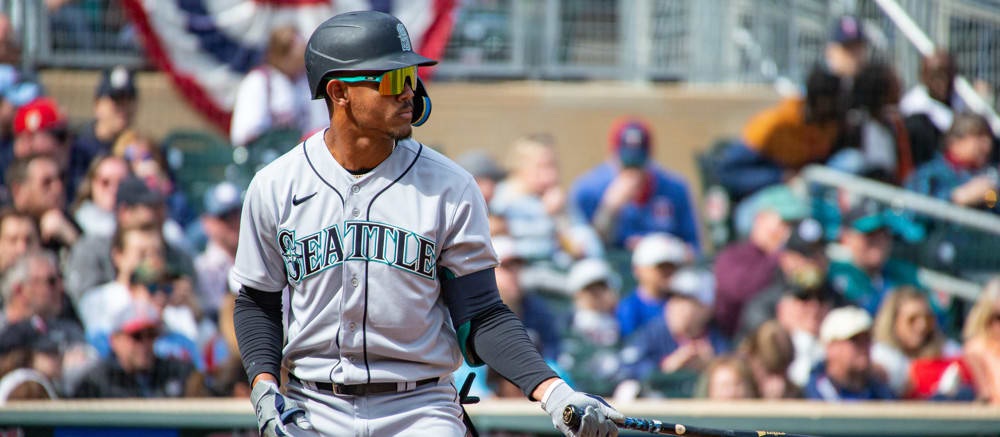This article is part of our Collette Calls series.
The numbers are in, and April was one of the worst months for offense in baseball in recent history. The final tallies:
- HR/Contact finished at its lowest April level since 2015 at 3.7%
- A .675 league-wide OPS was the worst since the league expanded to its current size in 1998
- The percentage of runs scored via the home run (36%) fell 12% over April of 2021 and to its lowest level since 2015
- The league pitched to a 3.71 ERA, which was easily the best in the expansion era
- Relievers had a 3.49 ERA, which slightly bested the 2015 April ERA but was nearly half a run lower than the 3.90 ERA put up by starting pitching in April.
The one area where we saw an uptick in offense: steals. April 2022's uptick in attempted steals ended four-season decline in that number.
Finally, we are seeing the league adjust to the current environment somewhat as we've seen an uptick over last season in steals attempted when the next base (2nd or 3rd) is unoccupied pic.twitter.com/JL7NW4URTk
— Jason Collette (@jasoncollette) May 1, 2022
Before we get too excited, notice that the 4.7% rate is still the second-lowest rate of the expansion era with only April of 2021 seeing a lower rate. The larger point is, any positive sign of offense is a welcomed one, so the fact we saw something swing in a positive direction during a month where nearly every other offensive measure declined precipitously from previous Aprils deserves a
The numbers are in, and April was one of the worst months for offense in baseball in recent history. The final tallies:
- HR/Contact finished at its lowest April level since 2015 at 3.7%
- A .675 league-wide OPS was the worst since the league expanded to its current size in 1998
- The percentage of runs scored via the home run (36%) fell 12% over April of 2021 and to its lowest level since 2015
- The league pitched to a 3.71 ERA, which was easily the best in the expansion era
- Relievers had a 3.49 ERA, which slightly bested the 2015 April ERA but was nearly half a run lower than the 3.90 ERA put up by starting pitching in April.
The one area where we saw an uptick in offense: steals. April 2022's uptick in attempted steals ended four-season decline in that number.
Finally, we are seeing the league adjust to the current environment somewhat as we've seen an uptick over last season in steals attempted when the next base (2nd or 3rd) is unoccupied pic.twitter.com/JL7NW4URTk
— Jason Collette (@jasoncollette) May 1, 2022
Before we get too excited, notice that the 4.7% rate is still the second-lowest rate of the expansion era with only April of 2021 seeing a lower rate. The larger point is, any positive sign of offense is a welcomed one, so the fact we saw something swing in a positive direction during a month where nearly every other offensive measure declined precipitously from previous Aprils deserves a deeper dive. It is also worth noting that Baseball America reported recently in a story (paywall) that stolen base attempts are way up in the minors -- 33% since 2018 to be exact -- while the success rate is nearly 79%. The new rules in the minors around limiting the number of pickoffs plus the pitch clock are certainly in play at that level, but it is conditioning prospects for potential steals as they reach the majors.
Let us first take a look at the numbers at a team level (numbers through play on May 3rd.)
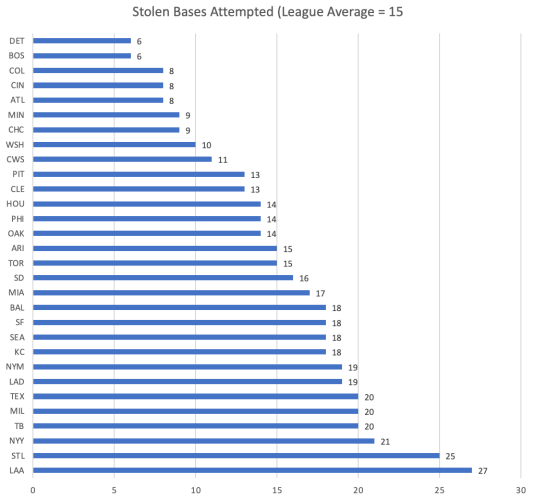
It is not surprising to see Joe Maddon's club at the top of the list with running as he has always been an aggressive running manager. It is also worth noting that only the Cubs were more active than the Angels in steals during spring training. What is surprising is the roster has continued running even though the club's success rate on steals has been below average. The stolen base success rate league-wide has been 73%, both overall as well as stolen base attempts of second and third base. The Angels are not even the worst team in the league as five other clubs have been worse at successfully converting their stolen base attempts.
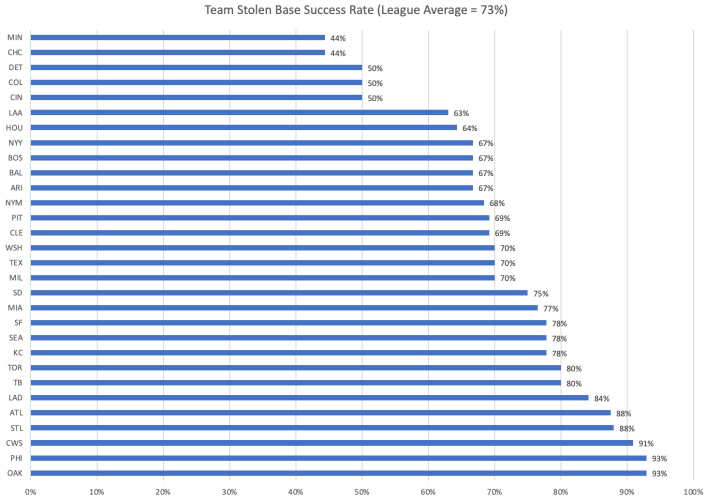
What is surprising is to see new manager Oliver Marmol putting the Cardinals in motion on a frequent basis and Aaron Boone putting the normally stationary Yankees into motion. Marmol and the Cardinals rarely ran during spring training (29th in the league) while the Yankees were surprisingly active in the spring (6th.)
There is one team which has many more opportunities than the others, and it is worth pointing out the Mets here because of the Buck Showalter factor. To put the Mets' number in perspective, the league average is 334, putting the club 30% over league average.
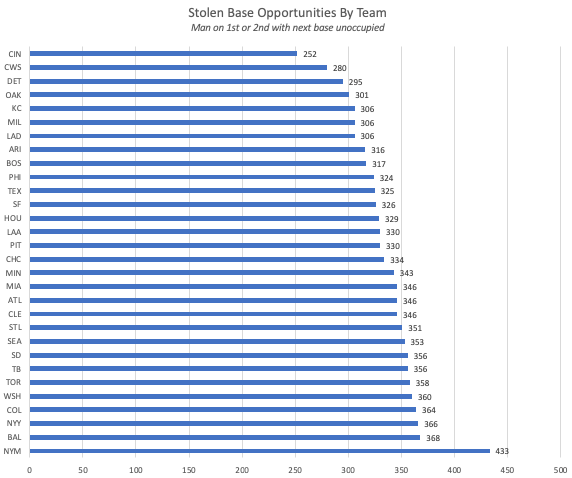
That total is impressive on its own because the Mets have certainly had their opportunity, but it also puts their 19 stolen bases attempted in a new light. Showalter has had a reputation of playing station-to-station baseball by eschewing the stolen base for the extra-base hit. That has not really changed this year, with the Mets only slightly ahead of the league average in attempted steals despite a sizable advantage in overall opportunities. We can see that when we divide each team's stolen base attempts (SBA) by their stolen base opportunities (SBO):
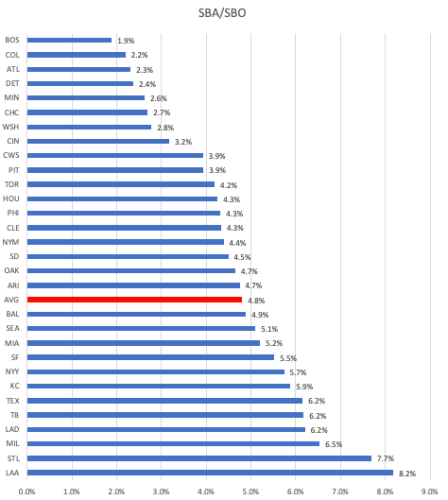
The teams near the top have not had the most opportunities, but they are also not letting opportunities go to waste. It is not surprising to see the Angels, Cardinals, Brewers and Rays up there as those managers have historically been aggressive with the running game. The aforementioned Marmol leading the Cardinals as well as Mike Matheny learning a new trick while managing the Royals, Chris Woodward putting the Rangers in motion and Aaron Boone pushing the notoriously stationary Yankees on the basepaths is surprising. You targeted certain players during draft season for speed, but that chart above gives you an early feel as to how those managers are handling the running game. The bottom five teams on that chart each have returning managers from last season, but those clubs are also using a more conservative approach with each of their clubs struggling offensively in different ways.
The individual player leaderboard shows some interesting data points as well. The table below shows all players with at least a 15% SBA/SBO measure on the season along with their success rate, successful attempts and caught stealings:
Player | Team | SBOpp | SBA | SB | CS | SB% | SBA/SBO |
|---|---|---|---|---|---|---|---|
KC | 13 | 5 | 5 | 0 | 100% | 38% | |
CWS | 18 | 6 | 5 | 1 | 83% | 33% | |
SF | 12 | 4 | 4 | 0 | 100% | 33% | |
SEA | 35 | 10 | 9 | 1 | 90% | 29% | |
NYY | 20 | 5 | 4 | 1 | 80% | 25% | |
LAA | 22 | 5 | 3 | 2 | 60% | 23% | |
SD | 18 | 4 | 2 | 2 | 50% | 22% | |
TB | 14 | 3 | 3 | 0 | 100% | 21% | |
BAL | 38 | 8 | 7 | 1 | 88% | 21% | |
SEA | 19 | 4 | 3 | 1 | 75% | 21% | |
LAA | 25 | 5 | 3 | 2 | 60% | 20% | |
ARI | 10 | 2 | 1 | 1 | 50% | 20% | |
SL | 10 | 2 | 1 | 1 | 50% | 20% | |
STL | 36 | 7 | 6 | 1 | 86% | 19% | |
LAA | 16 | 3 | 3 | 0 | 100% | 19% | |
MIA | 33 | 6 | 5 | 1 | 83% | 18% | |
NYM | 44 | 8 | 4 | 4 | 50% | 18% | |
KC | 33 | 6 | 4 | 2 | 67% | 18% | |
TB | 29 | 5 | 4 | 1 | 80% | 17% | |
PIT | 12 | 2 | 1 | 1 | 50% | 17% | |
STL | 37 | 6 | 6 | 0 | 100% | 16% | |
TEX | 31 | 5 | 4 | 1 | 80% | 16% | |
LAD | 26 | 4 | 3 | 1 | 75% | 15% | |
DET | 13 | 2 | 1 | 1 | 50% | 15% | |
CHC | 20 | 3 | 2 | 1 | 67% | 15% |
Mondesi is already done for the season, so let us pause for a moment and pour one out for money wasted on that talent in drafts this season. Seattle has seen both youngsters in Rodriguez and Kelenic struggle at the plate, but Scott Servais has let them both run. We should absolutely keep this in mind as Kyle Lewis makes his expected return to the roster this weekend, perhaps at the expense of Kelenic's roster spot. Locastro and Wade, teammates last year, now each has their own role on separate clubs as designated runners when the opportunities present themselves. Velasquez is now the player competing with Wade for pinch-running steals, and has thus far been successful in each of his attempts.
If homers continue to lag on the season, managers are going to look to find other ways to create runs. Some managers are getting ahead of the curve and returning to the days when stolen bases were an actual strategy in baseball and not something that happened with regularity of an appearance of Halley's Comet, and getting ahead of that movement should help you in your fantasy leagues.

